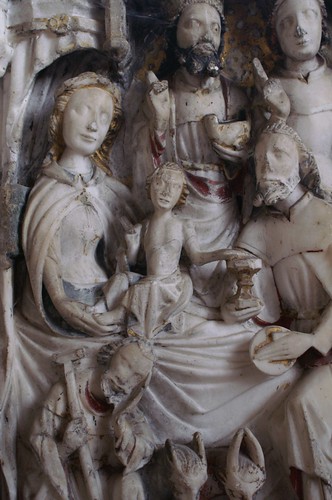Nottingham Alabaster Altarpieces
In the late Middle Ages the fashionable material for altarpieces in England was alabaster, a type of gypsum, which could be found in limited quantity in parts of south Nottinghamshire, Derbyshire and Staffordshire and was very easily worked. By the early part of the fifteenth century Nottingham had become something of a centre for the production of alabaster panels for use in altarpieces. Generally speaking the panels were fairly small in scale and they were used in groups wired up into a gessoed wooden frames. Often the panels were highlighted with colour and gilding. The images generally followed two themes the Life of Our Lady and the Passion of Christ. As alabaster is a very friable material, often the panels are in quite poor condition, but quite a lot of them still remain. The example above, portraying the arrest of Christ, is from a series of panels in Drayton in Berkshire. I include some more photos of the Drayton sequence.
The Adoration of the Magi, this is an image that would have been termed 'Our Lady in Jesyn' in the Middle Ages, Our Lady in Bed.
The Annunciation:
The scourging Christ:
Further reading:
The definitive works on the subject at both by Francis Cheetham, expensive but gloriously illustrated.
F. Cheetham, English Medieval Alabasters: With a Catalogue of the Collection in the Victoria and Albert Museum (London, 2005).
F. Cheetham, The Alabaster Images of Medieval England (Museum of London Medieval Finds 1150 -- 1450) (London, 2003)

Comments
Alabaster figures and scenes are a characteristic and very beautiful product of late medeval religious and artistic sensibility. We ought (All of us) to know more about them. Information concerning other reliable and informative online sites with material relating to the alanaster tradition would be very welcome!
Also otehr postings...
Philip Weller (Nottingham).